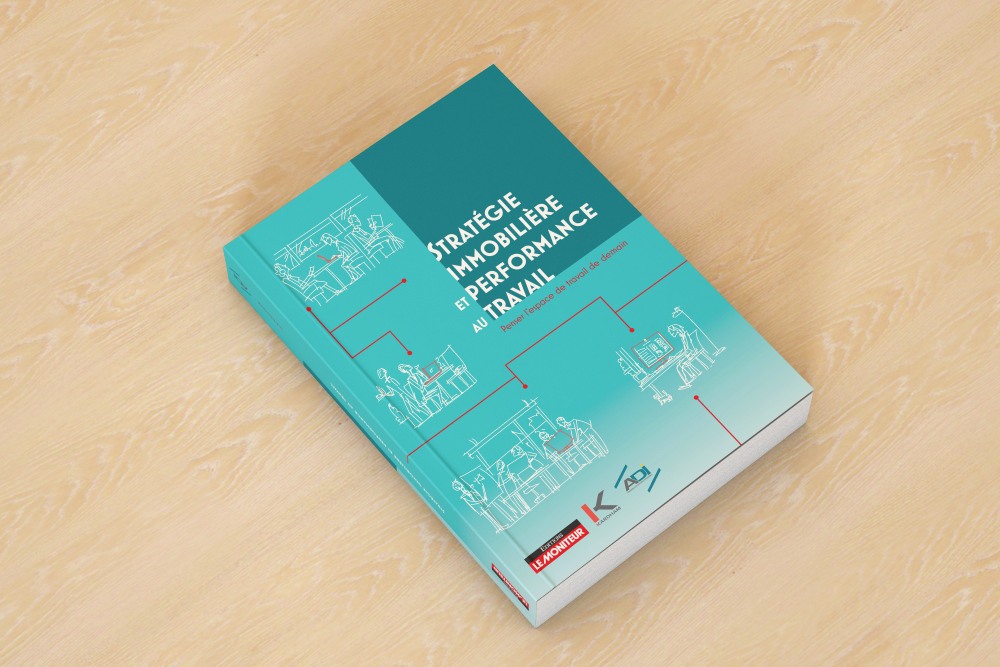- Home
- EN
- Kardham Group
- News
Publication of the book
March 2024

Or how to find and design the ideal office building.
With the Association des Directeurs Immobiliers (ADI), we have the pleasure to announce the release of " Real Estate Strategy and Workplace Performance - Designing Tomorrow's Workspace ". Published under the direction of Nicolas Cochard, Kardham's Research & Development Director, this practical guide attempts to draw a portrait of the ideal office from the point of view of the user experience through an all-encompassing approach - outside and inside the office building - by including the material and immaterial dimensions of the workspace: physical, functional and psychological performance. For while the physical aspects of the workspace can offer real leverage in terms of performance, it's the human context that will ensure that everyone has a positive experience of the workplace.
Establishing the link between the office and performance is an elusive task in the service sector.
Since the 19th century, in an industrial context, companies have sought to use space as a resource to maximize productivity, and in the case of industry, the links between spatial organization and performance were fairly simple to establish. Assessing the influence of the spatial organization of work on the performance of office workers, on the other hand, is much more difficult, as it involves both material and immaterial dimensions.
The exercise is made all the more difficult by the fact that many preconceived ideas circulate about the supposed effects of workspace on individual and collective performance, sometimes leading people to believe that the workplace can be a solution, while forgetting that it is above all a means, a resource that must be aligned with the organization, its culture and the way it functions. But also with the employees, and their environment, including outside the company. And that only the alignment of these material and immaterial aspects can contribute to the physical, functional and psychological performance of workspaces.
A practical guide for all departments
"Real Estate Strategy and Workplace Performance" sets out the factors that make office buildings a tool for performance, in all their different dimensions. Far from any incantatory thinking that a particular spatial form will produce a particular result in terms of performance, the 240-page book sets out the external and internal conditions that can be levers of performance. A practical guide that provides all the ingredients available to management - general management, human resources, finance, real estate, general services - to build a successful workspace. And it does so in the knowledge that the paths to success will differ from one person, organization or context to another.
Many ingredients make up the recipe for a successful workspace
- The book begins with a definition of the three dimensions of performance: physical performance, which focuses on conditions of physical comfort; functional performance, in which the space is used to ensure the conditions necessary to carry out one's mission; and psychological performance, in which the employee achieves a form of satisfaction related to the match between his or her environment, expectations and needs.
- He continues with a perspective on the office building in its urban context. How the location, neighborhood and exterior view of an office building, as well as its environmental performance and the notion of a serviced building, all play a part in quality of life and quality of work, and can guarantee a better occupant experience.
- The book goes on to look at performance levers relating to the physical work environment: or how comfort - physical, thermal, lighting, acoustic - air quality, biophilia, aesthetics, density, physical activity and health performance can all contribute to designing ideal offices. He reminds us that, while it is difficult to measure the productivity gains resulting from good physical comfort, we are nevertheless certain of the harmful effects of physical discomfort.
- He then draws up a typology of workspaces in order to understand their advantages and disadvantages: the closed individual office, the shared closed office, the combi-office, the flex office, activity-based working, multispatial working and telecommuting. Functional comfort, types of layout and office hours will also be addressed.
- Finally, it examines the links between space and organizational performance, shedding light on essential intangible notions such as psychological comfort, attachment, attractiveness, employer brand, identity, creativity, information flow, interaction, space management and inclusion.
To this end, the book offers a theoretical approach based on academic research, complemented by practical advice for all those involved in the production and management of tertiary work environments.
« Over the past few years, we've been wondering how to get employees back to the office. But what if we were wrong? "Why should they come back to the office?" seems a much more pertinent question. Like a cornerstone, the office carries the whole of a company's strategic vision: that of the real estate director responsible for operating assets, that of the human resources director committed to enhancing the attractiveness of his entity, that of the administrative and financial director who wants to improve the organization's financial performance through the right sizing of its assets, or that of the sustainable development & innovation director committed to decarbonizing real estate assets. And let's not forget that, in these times of change, the organization of workspaces through their layout must first and foremost meet the needs of employees. This is what we wanted to demonstrate with this book: that these needs are not all uniform, and that if there is such a thing as an ideal office, it must be seen as a place of equity and inclusion, enabling everyone to be hosted comfortably so that they can work effectively », Frédéric Goupil de Bouillé, President of the Association des Directeurs immobiliers.
« Hybrid working brings remote and on-site working into competition, and this allows organizations to renew their focus on their workspaces, which must be attractive. Throughout this book, we aim to demonstrate that this attractiveness depends on a number of factors, both tangible and intangible. Spatiality is complex, and the production process is at least as important as the product itself. The chapters in this book sketch out the optimal user path for an 'office worker', with the idea that the ideal office is one that is easy to get to, that people like to frequent because they work well there and feel good there », Nicolas Cochard, R&D Director at Kardham.
“Real estate strategy and performance at work - Designing tomorrow's workspace”, proposed by Kardham and ADI, is published by Editions Le Moniteur. 240 pages. An extract can be viewed here.
The publication of this book will be the subject of a webinar on Thursday, April 4, 2024 at 8:30 a.m.
Nicolas Cochard, Director of R&D at Kardham, accompanied by Frédéric Goupil de Bouillé, President of ADI & Executive Director at SNCF Immobilier, will unveil the tangible and intangible elements essential to building a successful, high-performance workspace, on a physical, functional and psychological level. Outside and inside the office building, what are the ingredients for a successful recipe? Register here

